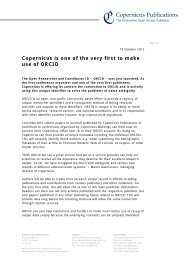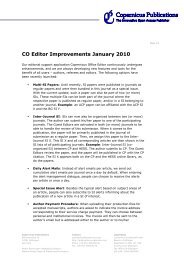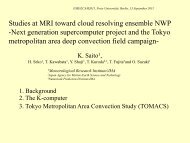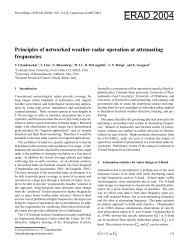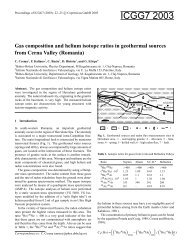ERAD 2002
ERAD 2002
ERAD 2002
Create successful ePaper yourself
Turn your PDF publications into a flip-book with our unique Google optimized e-Paper software.
K. Friedrich and M. Hagen: Vector fields using a bistatic Doppler radar 211<br />
(a) (b)<br />
Fig. 9. Horizontal cross–section of the horizontal wind–vector in<br />
m s −1 at a height of (a) 1.35 km and (b) 5.35 km above MSL underlaid<br />
by the vertical velocity in m s −1 for 3 May 2000, at 14:55 UTC.<br />
The horizontal wind was determined by the Doppler measurements<br />
of receivers OP and Lagerlechfeld. Upwinds are indicated by positive<br />
values, while negative values are downwinds. For clarity of<br />
display, only every third wind–vector is plotted.<br />
of 1.35 km and 5.35 km above MSL. The horizontal wind–<br />
vector at the lower troposphere showed strong divergences<br />
and convergences in speed and direction with an easterly<br />
and westerly flow at 1.35 km above MSL (Fig. 9a). Aloft,<br />
northwesterly to westerly winds dominated (Fig. 9b), with<br />
a noticeable confluence of the outflow on the southern part<br />
of the most active part of the system. The vertical velocity<br />
fields were characterized by a well–defined updraft located<br />
at 230 ◦ ≤ φt ≤ 270 ◦ at a range of 15 km ≤ rt ≤ 25 km and<br />
a downdraft area south of it. The magnitude of the up– and<br />
downdraft was continuously increasing from ground level up<br />
to the top. Maximum values of 6 m s −1 at a height of 5.35 km<br />
above MSL were reached in the updraft region and values of<br />
-5 m s −1 at 5.35 km above MSL in the southern downdraft<br />
region (Fig. 9b). Both positive and negative divergences of<br />
the horizontal wind–field were observed in the main updraft<br />
area.<br />
6 Conclusion<br />
Signatures of the horizontal wind–field (e.g. divergences, rotations,<br />
wind–shear) can be detected easily with a bistatic<br />
Doppler radar as presented here for two stratiform and one<br />
convective precipitation event. While the horizontal wind<br />
is measured in real–time, the quality–control and the vertical<br />
wind retrieval are applied afterwards. The three components<br />
of the wind–vector u, v, and w together with a confidence<br />
level for each horizontal wind–field is a great benefit<br />
for operational meteorology, e.g. weather surveillance, hazard<br />
warnings, and nowcasting of weather phenomena.<br />
The comprehensiveness and the emphasis to the quality–<br />
control scheme varied according to the weather situations.<br />
During the stratiform precipitation event, for instance, the<br />
quality of horizontal wind is dominated by F (σ ′ |Vh|) which<br />
is fixed for an experimental setup. Low impact is observed<br />
by F (∇Z) and F (σ ′ |Vh|/|Vh|). The emphasis on the quality<br />
control was set differently by the convective case. For<br />
instance, F (σ ′ |Vh|/|Vh|) could not be applied owing to the<br />
high wind–shear. On the other hand, the control for data<br />
consistency, such as the persistence check in time and space<br />
and investigation on sidelobe contamination, was more important.<br />
The cases discussed here show clearly that quality–<br />
control algorithms must be flexibly and independently applicable.<br />
The quality–control algorithm can also be applied to<br />
other horizontal wind–field measurements, e.g. monostatic<br />
dual–Doppler winds.<br />
References<br />
de Elia, R. and Zawadzki, I., Sidelobe contamination in bistatic<br />
radars, in Proc.29th Radar Meteorology Conf., Montreal, pp.<br />
218–220, Amer. Meteor. Soc., 1999.<br />
Friedrich, K., Determination of three–dimensional wind–vector<br />
fields using a bistatic Doppler radar network, Ph.D. thesis, Fakultaet<br />
fuer Physik, Ludwig–Maximilians–Universitaet Muenchen,<br />
http://www.op.dlr.de/ pa4k/, <strong>2002</strong>.<br />
Protat, A. and Zawadzki, I., A variational method for real–time retrieval<br />
of three–dimensional wind field from multiple–Doppler<br />
bistatic radar network data, J. Atmos. Oceanic Technol., 16, 432–<br />
449, 1999.<br />
Schroth, A. C., Chandra, M. S., and Meischner, P., A C–band coherent<br />
polarimetric radar for precipitation and cloud physics research,<br />
J. Atmos. Oceanic Technol., 5, 803–822, 1988.<br />
Wurman, J., Heckman, S., and Boccippio, D., A bistatic multiple–<br />
Doppler radar network, J. Appl. Meteor., 32, 1802–1814, 1993.




